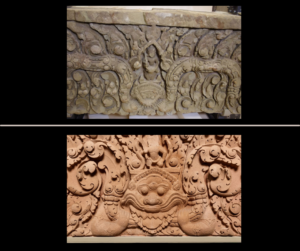Thai Cultural Property Case Edges Closer to Settlement
 |
| Lintels 1 and 2 from the Asian Art Museum. Photo: US Attorney Northern District of California. |
Lintels allegedly taken unlawfully from Thailand and given to the Asian Art Museum in California are the subject of a federal forfeiture complaint that seeks repatriation of the cultural property.
The case of United States of America v. Two One-Thousand-Five-Hundred-Pound, Hand-Carved Lintels Removed from Religious Temples in Thailand (N.D.Cal. 2020-cv-07537) started when the Consul General of Thailand spotted the architectural elements on display at the Asian Art Museum in 2016. He demanded their return, but the museum reportedly said nothing until the U.S. government intervened, a
ccording to a civil forfeiture complaint filed by federal lawyers in October 2020, which seeks title to the cultural artifacts.Archaeologists concluded that one lintel was from the Prasat Nong Hong Temple in Buriram Province, and the other was from the Prasat Khao Lon Temple in Sa Kaeo Province.
“With respect to LINTEL 2,” prosecutors contend that “COLLECTOR 1 indicated that a Thai lintel in his possession had been reported stolen by the Thai government, and that the Thai government had asked COLLECTOR 1 to return the lintel.”
Federal cultural property forfeiture cases like this one, where no bilateral agreement under the Cultural Property Implementation Act exists between the U.S. and Thailand, routinely rely on 19 U.S.C. § 1595a(c)(1)(A). That statute maintains that “merchandise shall be seized and forfeited if it is stolen, smuggled, or clandestinely imported or introduced.”
Here, federal prosecutors assert that the Thai lintels constitute property owned by Thailand that was removed without permission, suggesting that the lintels are stolen property subject to legal forfeiture by the U.S. But they more expressly claim that “LINTELS 1 and 2 were imported into the United States in violation of Thai law, i.e. without the requisite export documents.”
The U.S. does not enforce foreign export laws. But the McClain/Schultz doctrine–which goes unmentioned in the government’s forfeiture complaint–allows U.S. courts to recognize a foreign export regulation when the foreign nation’s cultural patrimony law clearly vests ownership in cultural property. Whether Thailand’s patrimony law sufficiently grants such title is not made particularly clear in the court complaint. United States .v Schultz, 333 F.3d 393 (2nd Cir. 2003); United States v. McClain, 545 F.2d 988 (5th Cir.1977).
Prosecutors mention that both Thailand’s 1934 Act on Ancient Monuments, Objects of Art, Antiquities and National Museums and its 1961 Act on Ancient Monuments, Antiques, Objects of Art, and National Museums “deem cultural artifacts, like LINTELS 1 and 2, state property.” But the attorneys do not express that the lintels either constitute or are derived from proceeds traceable to a violation of the National Stolen Property Act under either 18 U.S.C. §§ 2314 or 2315. Instead, they emphasize that these patrimony laws “govern whether and/or when a piece of art is permitted to be exported from Thailand;” that they “forbade the unlicensed export of archaeological artifacts from specifically named archeological sites, including the Prasat Nong Hong and Prasat Khao Lon Temples;” and that “[n]o person or entity ever sought an application for an export license or other form of permission to take these lintels out of the Kingdom of Thailand prior to their removal from the country.”
Text and original photos copyrighted 2010-2021 by Cultural Heritage Lawyer Rick St. Hilaire, a blog commenting on matters of cultural property law, art law, art crime, cultural heritage policy, antiquities trafficking, looted, antiquities, stolen relics, smuggled antiquities, illicit antiquities, museum risk management, and archaeology. Any unauthorized reproduction or retransmission without the express written consent of CHL is strictly prohibited. The materials presented on this site are for informational purposes only and do not constitute legal advice. Retain a lawyer to receive legal help. The provision of this information to the reader, moreover, in no way constitutes an attorney-client relationship. Blog url: culturalheritagelawyer.blogspot.com.

